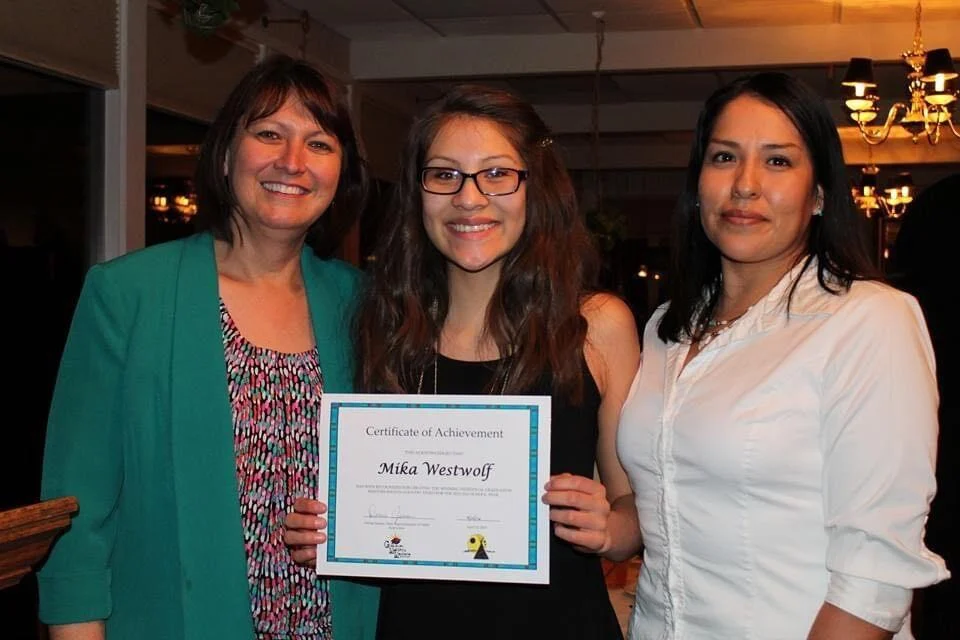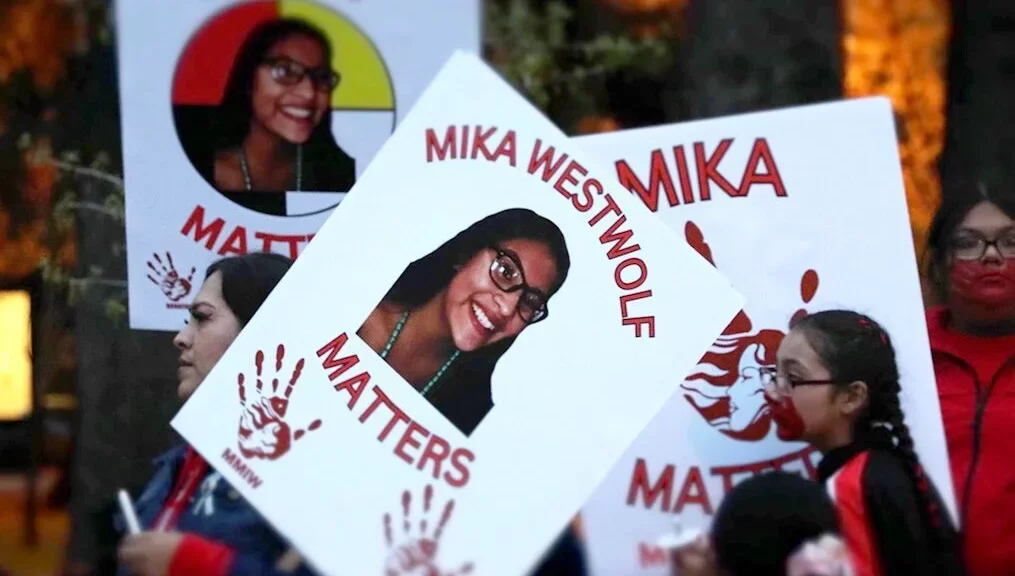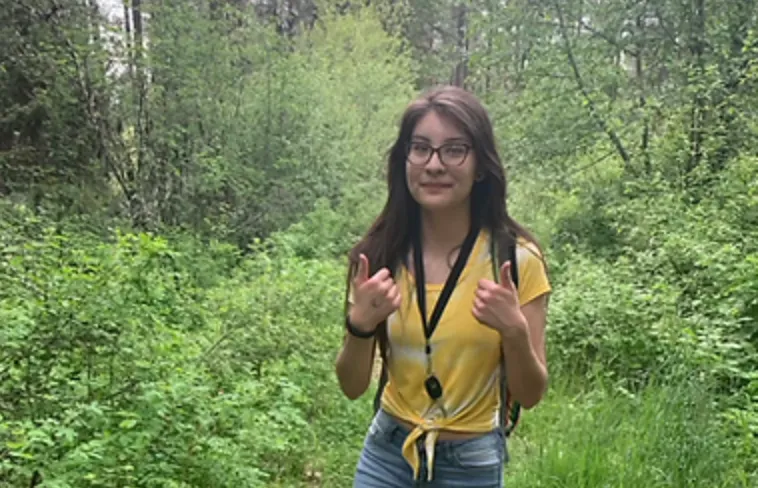A bit more than two months ago, 22-year-old Mika Westwolf was struck by a Cadillac Escalade cruising along Highway 93 near the Flathead Indian Reservation in Montana. Tribal police found Westwolf’s body on the side of the road around 4:00AM. She was pronounced dead at the scene. The vehicle, driven by a non-Indigenous woman named Sunny White, did not stop after the accident. There is a march scheduled next week to shed awareness about Mika, and the broader scourge of Missing and Murdered Indigenous women. According to a story in the Daily Mail, 239 people have been killed along this stretch of road since 2021. That is an incredible figure.
Westwolf, an enrolled member of the Blackfeet Nation, was a talented and bright young woman. She was an athlete, an artist, and an advocate for Indigenous peoples, one of four selected from her nation to visit a Sherpa community in Nepal as part of a cultural exchange program. She had been walking along the side of the road, a bit north of the town of Arlee. She had been at a bar called the 4-Star Bar, but had left to retrieve her cell phone, which she believed she had left at home (it actually was in her brother’s car). Her family wants answers, but they have found little reassurance from the Montana Highway Patrol. The lead investigator, Trooper Wayne Bieber, left Mika’s family convinced that her case was not in good hands. Trooper Bieber seemed not to know the basic facts of the case, and seemed inclined to believe that whatever happened that night, Mika was at fault. Bieber told the family that walking along the shoulder of a road while intoxicated was illegal in Montana. The state police seemed uninterested in investigating Sunny White at all. She had been arrested shortly after the accident, but released soon after, pending toxicology reports. Bieber assumed that Mika was drunk, and that therefore Sunny White did not commit a crime. That first assumption has not been confirmed, and the second one is absolutely false.

I stumbled across Mika’s story during a summer when I have been trying to complete a history of the Onondaga Nation, which I have been working on now for several years. I could not help but notice the parallels between Mika’s death and the deaths of so many Onondagas over so many years on the Onondaga Nation Territory. Like the road Mika traveled, the routes through the Onondaga Nation territory were dangerous. Onondagas died with disturbing regularity on the roadways passing through their Nation. George Van Every, for instance, one of the oldest of the Nation’s chiefs, was killed in September 1933 when a bus struck his horse-drawn buggy. He was an important figure on the Nation’s history. Too many Onondagas were struck and killed by too many inattentive drivers. Jesse Lyons told the House Indian Affairs Committee that “since we allowed them to build highways across our reservation, 30 Indians have been killed by automobiles and not a white man has been prosecuted.”That was in 1935. Louis Beckman, a veteran who had just received his honorable discharge after serving in World War II, and his friend Olive Sullivan, were killed walking along South Salina Street in the very early hours of one morning in February 1946. The driver who struck them was not charged. Anna Mae and Alice Jones, aged seven and eleven, received a total of $5750 in damages after a negligent driver passing through the Nation struck them that same year. Howard Hill, a Carlisle alum, died after a car driven by his neighbor Andrew Pierce struck and killed him in 1950. And in November 1950, 68-year-old Jamison Thomas died after a car struck him as he pulled a wood-laden cart along a road in Nedrow, near the reservation. He had joined the circus at the age of fourteen, was a skilled horseman. He lived alone, a life-long bachelor. He followed the traditional religion and instructed many of his neighbors on its central tenets. The men who bore his coffin to the burying ground read like a who’s who of important Onondaga leaders. Many had attended boarding school. Theodore Thomas, the Tadodaho George Thomas, Ike Lyons, Albert White, and Henry Homer. They were old men now, and they felt his loss. And it just goes on. Oren Lyons, 47, was killed when hit by an automobile driving on Route 11A on the Nedrow reservation. Martin Moses, a 6 year old, was killed on September 5th, 1957 “when struck by an automobile on a road in the Onondaga Reservation south of Syracuse.”
With the one exception when damages were paid, no one was ever punished in these accidents. They were deemed natural, part of the normal course of business. Poor people walked. People with more money drove. Sometimes the latter struck the former, and sometimes the former died. Nothing to see here, the authorities seemed to suggest. Best to not be poor. Best to not walk along the roadway.
And that is what seems to be the case in the Mika Westwolf case. Nothing criminal, in the eyes of the state police, has occurred. If Westwolf was intoxicated, as the Trooper Bieber seemed to suggest, she may as well have had it coming. It’s infuriating.
I lived in Montana for four years in the middle of the 1990s. I was struck during my time there by how casually racist statements about Indigenous people were made. Native Americans were drunks and reprobates. Their deaths and their disappearance seemed natural, and certainly it was beyond the power of white people to prevent it from happening. The racist attitudes held by many Montanans toward Indigenous peoples could justify their deaths. An Indian woman hit by a car late at night? Of course she was intoxicated, because Indians drink too much. The logic is reductive and violent.
Despite the racism, I had a great fondness for Montana. I learned to teach there. For the first time in my career, I had a significant number of Native American students. I still follow news from the state. And I have read, frequently over the past years, about the number of MMIW cases that have taken place in Montana. The state remains a dangerous place to be Indian. This pains me greatly.
And it also stinks to high hell, because you do not have to read very much to determine that Sunny White is a monster. Although law enforcement officers have resisted drawing what seems like so real a possibility, this case could easily be a hate crime. Of course accidents happen. Sometimes they truly are tragic, terrible events beyond anyone’s control. But Sunny White was a reputed drug user with a criminal record, and an avowed White Nationalist. To dispel any doubt about this, she named her two children “Aryan” and “Nation.” That a hateful racist could hit a young Indigenous woman with her car and keep going is sickening, but it should not surprise any of us.
The death of Mika Westwolf underscores the urgent need for even more decisive action on the part of federal authorities to address the continuing crisis of Missing and Murdered Indigenous persons. In this case, it is hard to escape the conclusion that the state police are incompetent or, worse, that they are covering up a terrible crime. We need more data, to be sure, but beyond that, we need a commitment to the simple principle that the lives of Indigenous people, whatever the racists and the dingbats and the goons believe, are as valuable as the lives of any one else. In Montana, certainly, that this principle is widely held remains very much in doubt. There is a Go Fund Me Page established by Mika’s family. Help if you can.




It’s perhaps unsurprising that her last name is White.
And sadly from her recent court appearance (https://missoulian.com/news/local/crime-courts/arlee-fatal-suspect-arraigned-in-butte-on-burglary-parental-interference-charges/article_2fe318fa-f5b3-11ed-b3f5-6b822ec0b366.html) for burglary and “parental interference,” both of which are felonies, she looks pregnant with another kid she’ll likely name Supremacy.
This woman is obviously a clinical psychopath.
Clearly law enforcement support, and probably are, white supremacists. For shame.